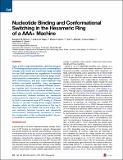| dc.contributor.author | Stinson, Benjamin Michael | |
| dc.contributor.author | Nager, Andrew Ross | |
| dc.contributor.author | Glynn, Steven E. | |
| dc.contributor.author | Schmitz, Karl R. | |
| dc.contributor.author | Baker, Tania | |
| dc.contributor.author | Sauer, Robert T | |
| dc.date.accessioned | 2013-12-19T17:16:21Z | |
| dc.date.available | 2013-12-19T17:16:21Z | |
| dc.date.issued | 2013-04 | |
| dc.identifier.issn | 00928674 | |
| dc.identifier.uri | http://hdl.handle.net/1721.1/82944 | |
| dc.description.abstract | ClpX, a AAA+ ring homohexamer, uses the energy of ATP binding and hydrolysis to power conformational changes that unfold and translocate target proteins into the ClpP peptidase for degradation. In multiple crystal structures, some ClpX subunits adopt nucleotide-loadable conformations, others adopt unloadable conformations, and each conformational class exhibits substantial variability. Using mutagenesis of individual subunits in covalently tethered hexamers together with fluorescence methods to assay the conformations and nucleotide-binding properties of these subunits, we demonstrate that dynamic interconversion between loadable and unloadable conformations is required to couple ATP hydrolysis by ClpX to mechanical work. ATP binding to different classes of subunits initially drives staged allosteric changes, which set the conformation of the ring to allow hydrolysis and linked mechanical steps. Subunit switching between loadable and unloadable conformations subsequently isomerizes or resets the configuration of the nucleotide-loaded ring and is required for mechanical function. | en_US |
| dc.description.sponsorship | National Center for Research Resources (U.S.) (NCRR 5P41RR015301-10) | en_US |
| dc.description.sponsorship | National Institute of General Medical Sciences (U.S.) (NIGMS (8 P41 GM103403-10)) | en_US |
| dc.description.sponsorship | National Institutes of Health (U.S.) (NIH grant GM-101988) | en_US |
| dc.language.iso | en_US | |
| dc.publisher | Elsevier B.V. | en_US |
| dc.relation.isversionof | http://dx.doi.org/10.1016/j.cell.2013.03.029 | en_US |
| dc.rights | Article is made available in accordance with the publisher's policy and may be subject to US copyright law. Please refer to the publisher's site for terms of use. | en_US |
| dc.source | Elsevier Open Archive | en_US |
| dc.title | Nucleotide Binding and Conformational Switching in the Hexameric Ring of a AAA+ Machine | en_US |
| dc.type | Article | en_US |
| dc.identifier.citation | Stinson, Benjamin M., Andrew R. Nager, Steven E. Glynn, Karl R. Schmitz, Tania A. Baker, and Robert T. Sauer. “Nucleotide Binding and Conformational Switching in the Hexameric Ring of a AAA+ Machine.” Cell 153, no. 3 (April 2013): 628-639. © 2013 Elsevier Inc. | en_US |
| dc.contributor.department | Massachusetts Institute of Technology. Department of Biology | en_US |
| dc.contributor.mitauthor | Stinson, Benjamin Michael | en_US |
| dc.contributor.mitauthor | Nager, Andrew Ross | en_US |
| dc.contributor.mitauthor | Glynn, Steven E. | en_US |
| dc.contributor.mitauthor | Schmitz, Karl R. | en_US |
| dc.contributor.mitauthor | Baker, Tania | en_US |
| dc.contributor.mitauthor | Sauer, Robert T. | en_US |
| dc.relation.journal | Cell | en_US |
| dc.eprint.version | Final published version | en_US |
| dc.type.uri | http://purl.org/eprint/type/JournalArticle | en_US |
| eprint.status | http://purl.org/eprint/status/PeerReviewed | en_US |
| dspace.orderedauthors | Stinson, Benjamin M.; Nager, Andrew R.; Glynn, Steven E.; Schmitz, Karl R.; Baker, Tania A.; Sauer, Robert T. | en_US |
| dc.identifier.orcid | https://orcid.org/0000-0002-9309-8662 | |
| dc.identifier.orcid | https://orcid.org/0000-0002-1719-5399 | |
| mit.license | PUBLISHER_POLICY | en_US |
| mit.metadata.status | Complete | |
